Analysis of Cross Culture Management Report for Hydro Generation
VerifiedAdded on 2023/01/03
|11
|3102
|1
Report
AI Summary
This report provides a comprehensive analysis of cross-culture management, focusing on Hydro Generation's (HG) major dam project in Tanzania. It addresses key aspects including national culture, leadership styles, and motivation & HRM strategies. The report examines Hofstede's cultural dimensions, particularly the power distance index and its implications on leadership, recommending the implementation of a laissez-faire leadership style due to the unique cultural context of Tanzania. The report also highlights the importance of employee motivation and HRM practices to ensure project success. It emphasizes the need for monitoring employee performance, adapting to local cultural nuances, and implementing strategies to enhance workforce engagement. This report aims to guide HG in effectively navigating the complexities of cross-culture management within the Tanzanian context.
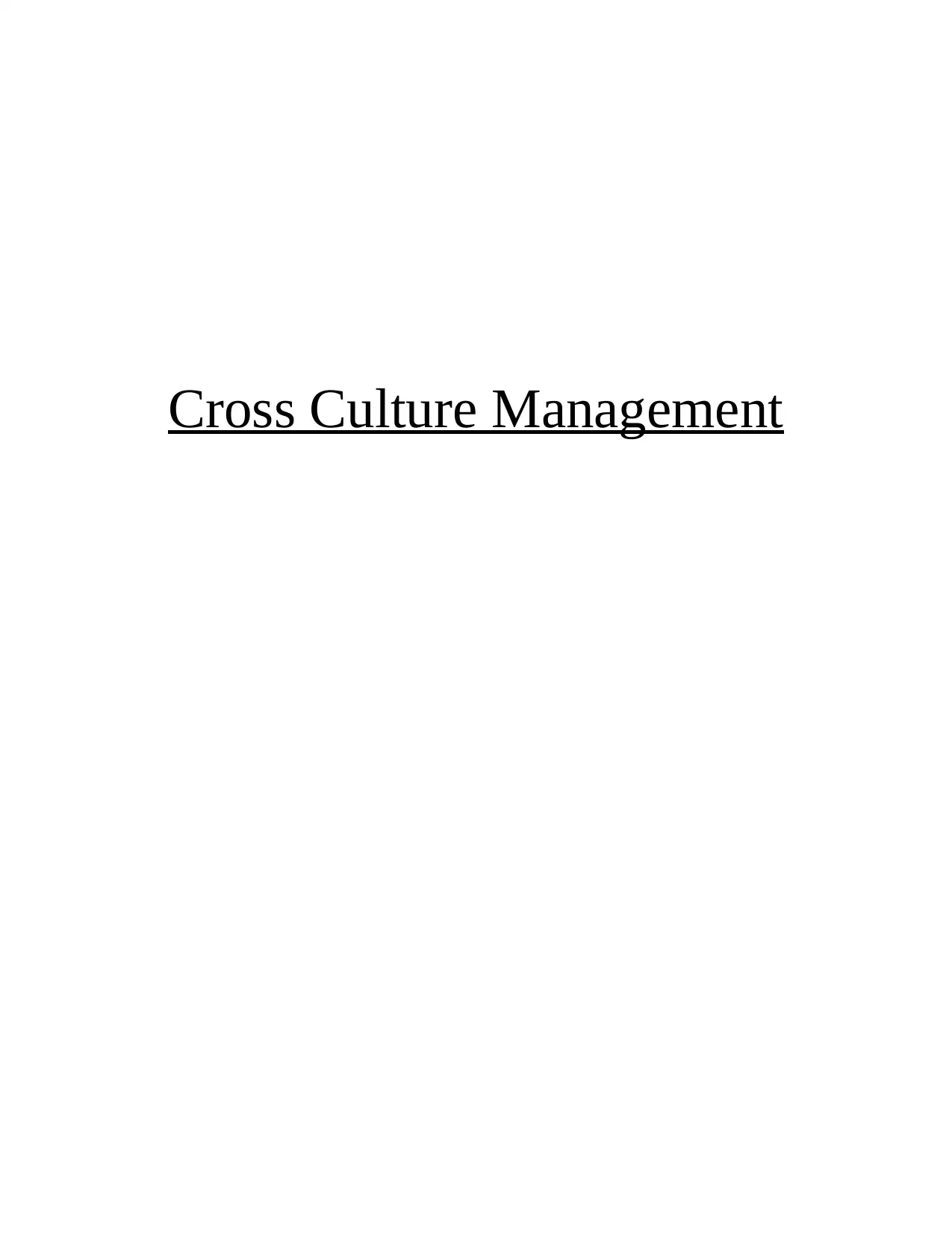
Cross Culture Management
Paraphrase This Document
Need a fresh take? Get an instant paraphrase of this document with our AI Paraphraser
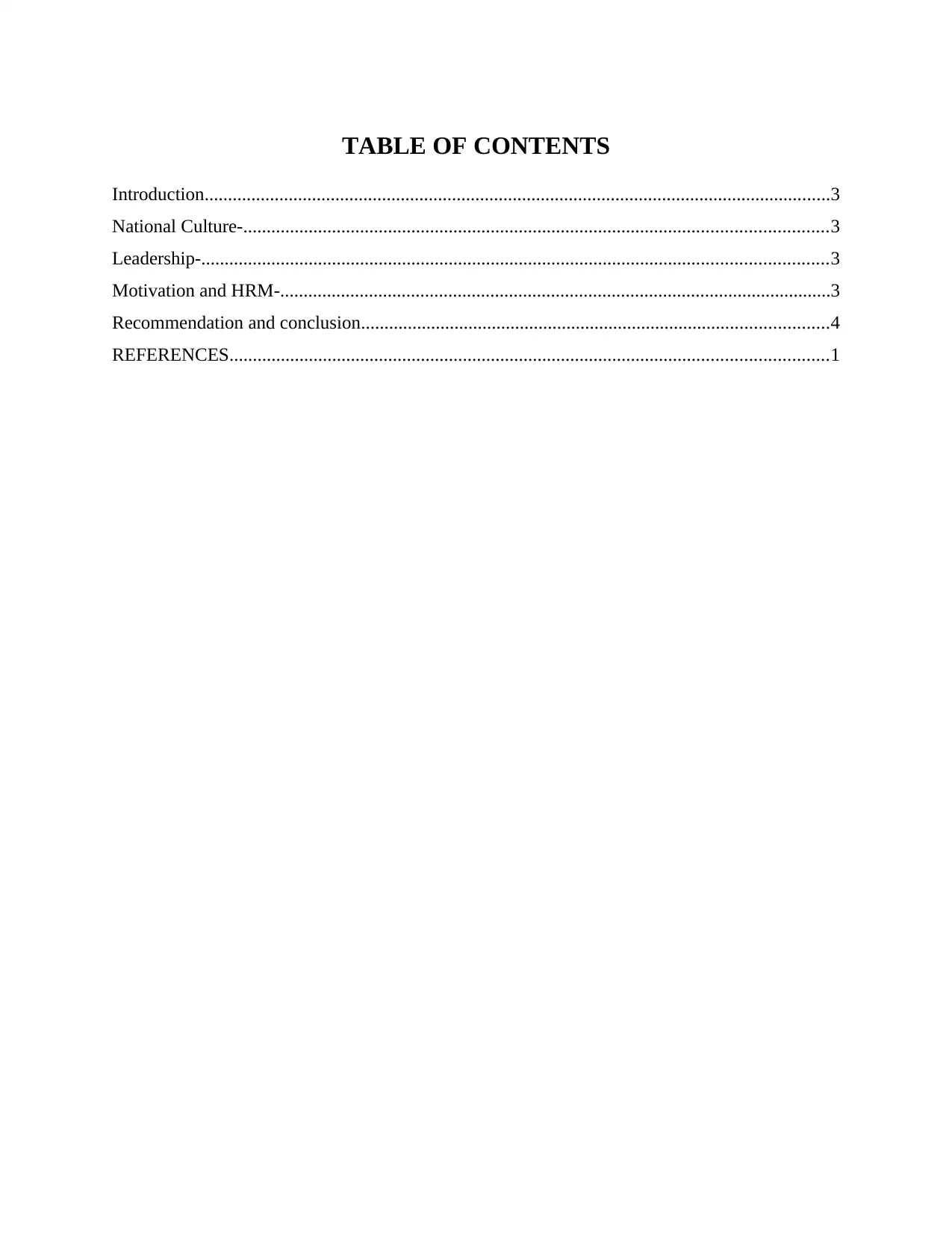
TABLE OF CONTENTS
Introduction......................................................................................................................................3
National Culture-.............................................................................................................................3
Leadership-......................................................................................................................................3
Motivation and HRM-......................................................................................................................3
Recommendation and conclusion....................................................................................................4
REFERENCES................................................................................................................................1
Introduction......................................................................................................................................3
National Culture-.............................................................................................................................3
Leadership-......................................................................................................................................3
Motivation and HRM-......................................................................................................................3
Recommendation and conclusion....................................................................................................4
REFERENCES................................................................................................................................1
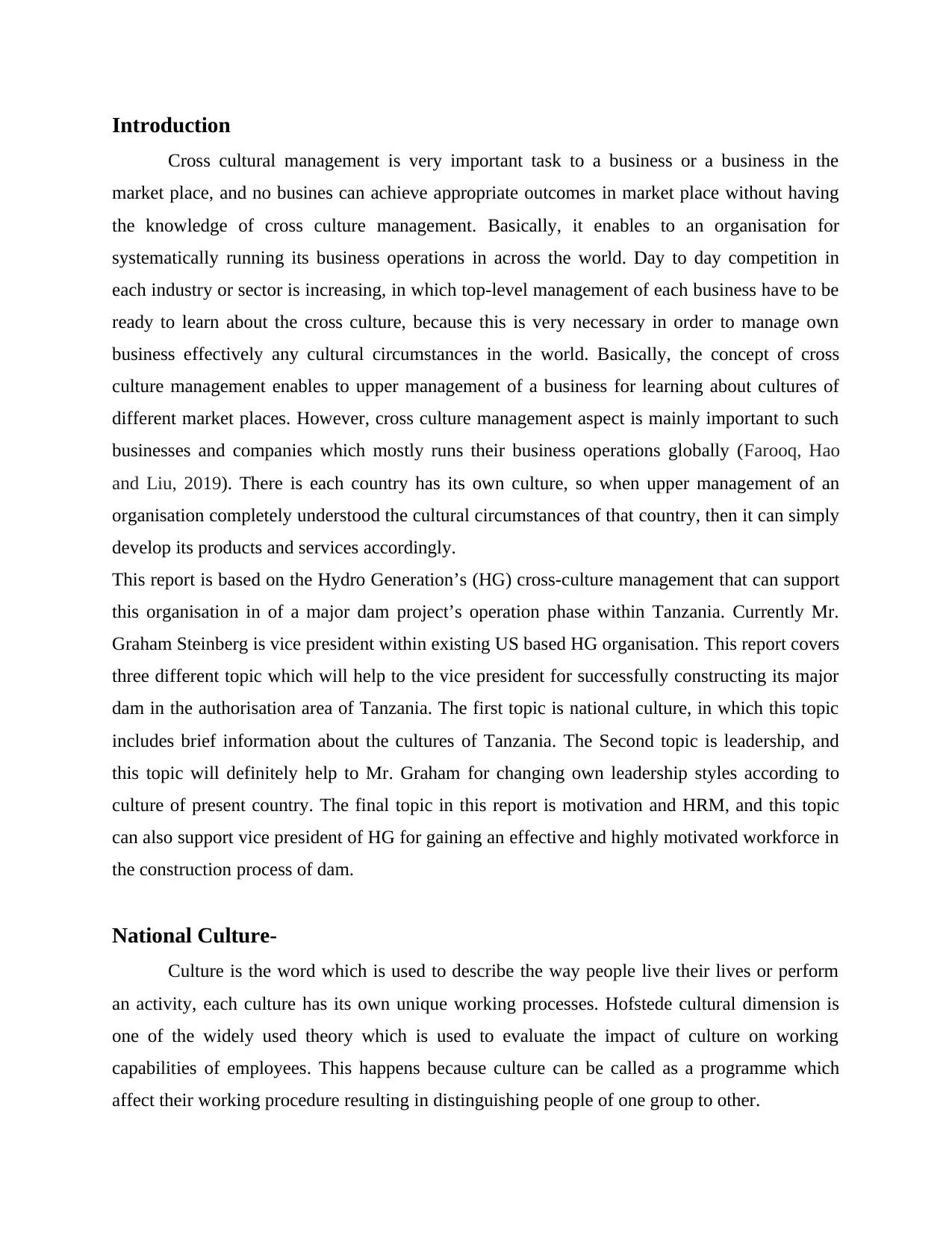
Introduction
Cross cultural management is very important task to a business or a business in the
market place, and no busines can achieve appropriate outcomes in market place without having
the knowledge of cross culture management. Basically, it enables to an organisation for
systematically running its business operations in across the world. Day to day competition in
each industry or sector is increasing, in which top-level management of each business have to be
ready to learn about the cross culture, because this is very necessary in order to manage own
business effectively any cultural circumstances in the world. Basically, the concept of cross
culture management enables to upper management of a business for learning about cultures of
different market places. However, cross culture management aspect is mainly important to such
businesses and companies which mostly runs their business operations globally (Farooq, Hao
and Liu, 2019). There is each country has its own culture, so when upper management of an
organisation completely understood the cultural circumstances of that country, then it can simply
develop its products and services accordingly.
This report is based on the Hydro Generation’s (HG) cross-culture management that can support
this organisation in of a major dam project’s operation phase within Tanzania. Currently Mr.
Graham Steinberg is vice president within existing US based HG organisation. This report covers
three different topic which will help to the vice president for successfully constructing its major
dam in the authorisation area of Tanzania. The first topic is national culture, in which this topic
includes brief information about the cultures of Tanzania. The Second topic is leadership, and
this topic will definitely help to Mr. Graham for changing own leadership styles according to
culture of present country. The final topic in this report is motivation and HRM, and this topic
can also support vice president of HG for gaining an effective and highly motivated workforce in
the construction process of dam.
National Culture-
Culture is the word which is used to describe the way people live their lives or perform
an activity, each culture has its own unique working processes. Hofstede cultural dimension is
one of the widely used theory which is used to evaluate the impact of culture on working
capabilities of employees. This happens because culture can be called as a programme which
affect their working procedure resulting in distinguishing people of one group to other.
Cross cultural management is very important task to a business or a business in the
market place, and no busines can achieve appropriate outcomes in market place without having
the knowledge of cross culture management. Basically, it enables to an organisation for
systematically running its business operations in across the world. Day to day competition in
each industry or sector is increasing, in which top-level management of each business have to be
ready to learn about the cross culture, because this is very necessary in order to manage own
business effectively any cultural circumstances in the world. Basically, the concept of cross
culture management enables to upper management of a business for learning about cultures of
different market places. However, cross culture management aspect is mainly important to such
businesses and companies which mostly runs their business operations globally (Farooq, Hao
and Liu, 2019). There is each country has its own culture, so when upper management of an
organisation completely understood the cultural circumstances of that country, then it can simply
develop its products and services accordingly.
This report is based on the Hydro Generation’s (HG) cross-culture management that can support
this organisation in of a major dam project’s operation phase within Tanzania. Currently Mr.
Graham Steinberg is vice president within existing US based HG organisation. This report covers
three different topic which will help to the vice president for successfully constructing its major
dam in the authorisation area of Tanzania. The first topic is national culture, in which this topic
includes brief information about the cultures of Tanzania. The Second topic is leadership, and
this topic will definitely help to Mr. Graham for changing own leadership styles according to
culture of present country. The final topic in this report is motivation and HRM, and this topic
can also support vice president of HG for gaining an effective and highly motivated workforce in
the construction process of dam.
National Culture-
Culture is the word which is used to describe the way people live their lives or perform
an activity, each culture has its own unique working processes. Hofstede cultural dimension is
one of the widely used theory which is used to evaluate the impact of culture on working
capabilities of employees. This happens because culture can be called as a programme which
affect their working procedure resulting in distinguishing people of one group to other.
⊘ This is a preview!⊘
Do you want full access?
Subscribe today to unlock all pages.

Trusted by 1+ million students worldwide
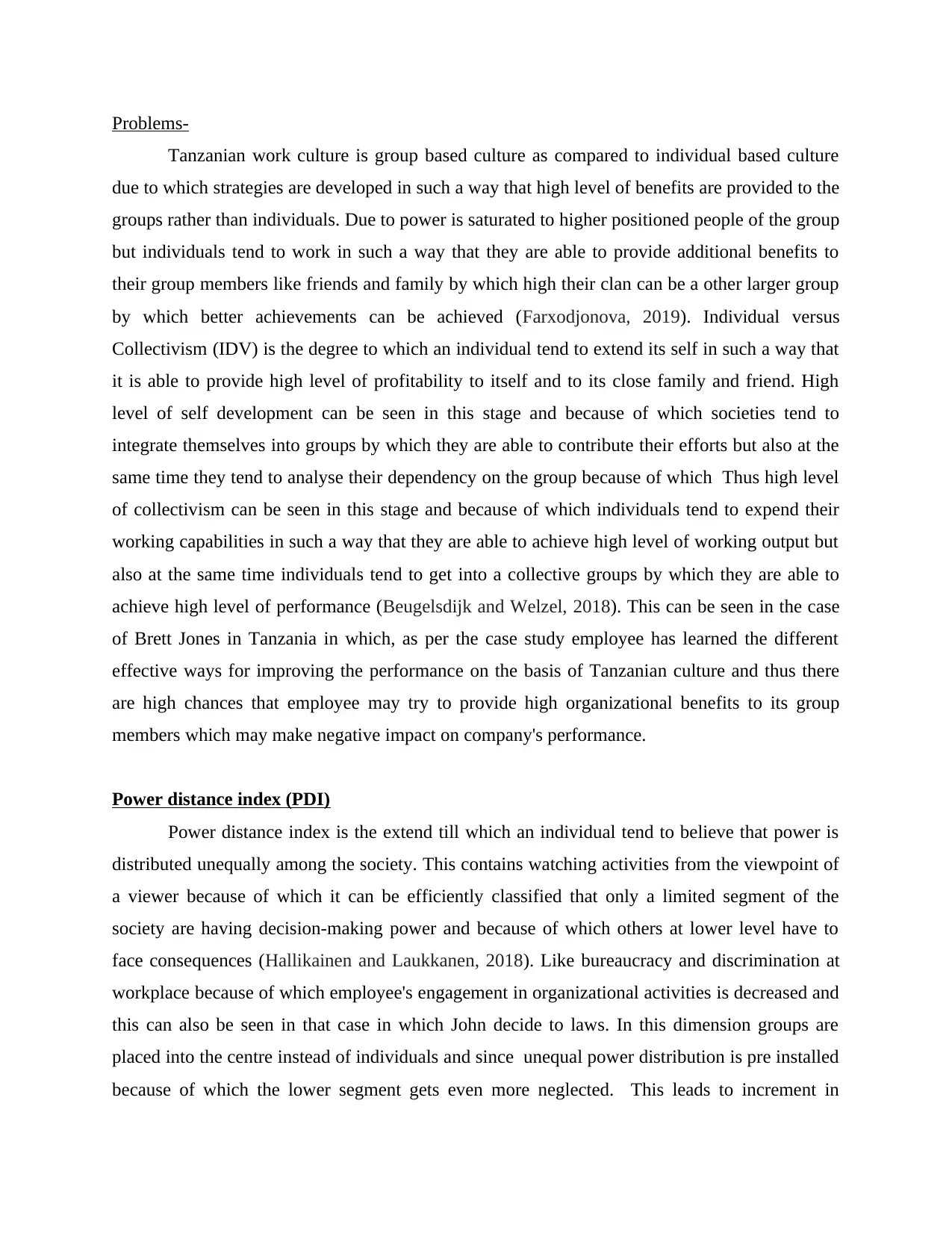
Problems-
Tanzanian work culture is group based culture as compared to individual based culture
due to which strategies are developed in such a way that high level of benefits are provided to the
groups rather than individuals. Due to power is saturated to higher positioned people of the group
but individuals tend to work in such a way that they are able to provide additional benefits to
their group members like friends and family by which high their clan can be a other larger group
by which better achievements can be achieved (Farxodjonova, 2019). Individual versus
Collectivism (IDV) is the degree to which an individual tend to extend its self in such a way that
it is able to provide high level of profitability to itself and to its close family and friend. High
level of self development can be seen in this stage and because of which societies tend to
integrate themselves into groups by which they are able to contribute their efforts but also at the
same time they tend to analyse their dependency on the group because of which Thus high level
of collectivism can be seen in this stage and because of which individuals tend to expend their
working capabilities in such a way that they are able to achieve high level of working output but
also at the same time individuals tend to get into a collective groups by which they are able to
achieve high level of performance (Beugelsdijk and Welzel, 2018). This can be seen in the case
of Brett Jones in Tanzania in which, as per the case study employee has learned the different
effective ways for improving the performance on the basis of Tanzanian culture and thus there
are high chances that employee may try to provide high organizational benefits to its group
members which may make negative impact on company's performance.
Power distance index (PDI)
Power distance index is the extend till which an individual tend to believe that power is
distributed unequally among the society. This contains watching activities from the viewpoint of
a viewer because of which it can be efficiently classified that only a limited segment of the
society are having decision-making power and because of which others at lower level have to
face consequences (Hallikainen and Laukkanen, 2018). Like bureaucracy and discrimination at
workplace because of which employee's engagement in organizational activities is decreased and
this can also be seen in that case in which John decide to laws. In this dimension groups are
placed into the centre instead of individuals and since unequal power distribution is pre installed
because of which the lower segment gets even more neglected. This leads to increment in
Tanzanian work culture is group based culture as compared to individual based culture
due to which strategies are developed in such a way that high level of benefits are provided to the
groups rather than individuals. Due to power is saturated to higher positioned people of the group
but individuals tend to work in such a way that they are able to provide additional benefits to
their group members like friends and family by which high their clan can be a other larger group
by which better achievements can be achieved (Farxodjonova, 2019). Individual versus
Collectivism (IDV) is the degree to which an individual tend to extend its self in such a way that
it is able to provide high level of profitability to itself and to its close family and friend. High
level of self development can be seen in this stage and because of which societies tend to
integrate themselves into groups by which they are able to contribute their efforts but also at the
same time they tend to analyse their dependency on the group because of which Thus high level
of collectivism can be seen in this stage and because of which individuals tend to expend their
working capabilities in such a way that they are able to achieve high level of working output but
also at the same time individuals tend to get into a collective groups by which they are able to
achieve high level of performance (Beugelsdijk and Welzel, 2018). This can be seen in the case
of Brett Jones in Tanzania in which, as per the case study employee has learned the different
effective ways for improving the performance on the basis of Tanzanian culture and thus there
are high chances that employee may try to provide high organizational benefits to its group
members which may make negative impact on company's performance.
Power distance index (PDI)
Power distance index is the extend till which an individual tend to believe that power is
distributed unequally among the society. This contains watching activities from the viewpoint of
a viewer because of which it can be efficiently classified that only a limited segment of the
society are having decision-making power and because of which others at lower level have to
face consequences (Hallikainen and Laukkanen, 2018). Like bureaucracy and discrimination at
workplace because of which employee's engagement in organizational activities is decreased and
this can also be seen in that case in which John decide to laws. In this dimension groups are
placed into the centre instead of individuals and since unequal power distribution is pre installed
because of which the lower segment gets even more neglected. This leads to increment in
Paraphrase This Document
Need a fresh take? Get an instant paraphrase of this document with our AI Paraphraser
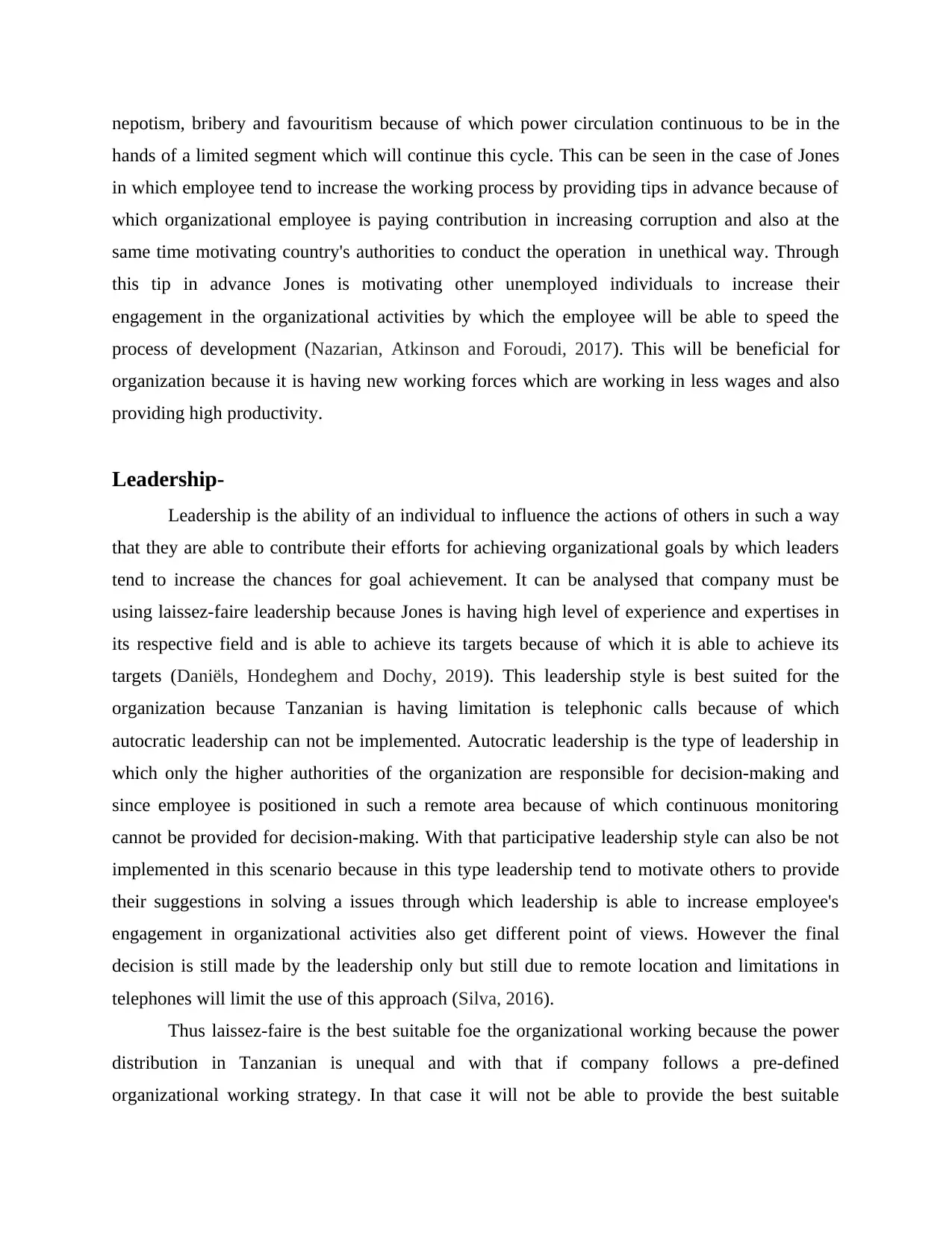
nepotism, bribery and favouritism because of which power circulation continuous to be in the
hands of a limited segment which will continue this cycle. This can be seen in the case of Jones
in which employee tend to increase the working process by providing tips in advance because of
which organizational employee is paying contribution in increasing corruption and also at the
same time motivating country's authorities to conduct the operation in unethical way. Through
this tip in advance Jones is motivating other unemployed individuals to increase their
engagement in the organizational activities by which the employee will be able to speed the
process of development (Nazarian, Atkinson and Foroudi, 2017). This will be beneficial for
organization because it is having new working forces which are working in less wages and also
providing high productivity.
Leadership-
Leadership is the ability of an individual to influence the actions of others in such a way
that they are able to contribute their efforts for achieving organizational goals by which leaders
tend to increase the chances for goal achievement. It can be analysed that company must be
using laissez-faire leadership because Jones is having high level of experience and expertises in
its respective field and is able to achieve its targets because of which it is able to achieve its
targets (Daniëls, Hondeghem and Dochy, 2019). This leadership style is best suited for the
organization because Tanzanian is having limitation is telephonic calls because of which
autocratic leadership can not be implemented. Autocratic leadership is the type of leadership in
which only the higher authorities of the organization are responsible for decision-making and
since employee is positioned in such a remote area because of which continuous monitoring
cannot be provided for decision-making. With that participative leadership style can also be not
implemented in this scenario because in this type leadership tend to motivate others to provide
their suggestions in solving a issues through which leadership is able to increase employee's
engagement in organizational activities also get different point of views. However the final
decision is still made by the leadership only but still due to remote location and limitations in
telephones will limit the use of this approach (Silva, 2016).
Thus laissez-faire is the best suitable foe the organizational working because the power
distribution in Tanzanian is unequal and with that if company follows a pre-defined
organizational working strategy. In that case it will not be able to provide the best suitable
hands of a limited segment which will continue this cycle. This can be seen in the case of Jones
in which employee tend to increase the working process by providing tips in advance because of
which organizational employee is paying contribution in increasing corruption and also at the
same time motivating country's authorities to conduct the operation in unethical way. Through
this tip in advance Jones is motivating other unemployed individuals to increase their
engagement in the organizational activities by which the employee will be able to speed the
process of development (Nazarian, Atkinson and Foroudi, 2017). This will be beneficial for
organization because it is having new working forces which are working in less wages and also
providing high productivity.
Leadership-
Leadership is the ability of an individual to influence the actions of others in such a way
that they are able to contribute their efforts for achieving organizational goals by which leaders
tend to increase the chances for goal achievement. It can be analysed that company must be
using laissez-faire leadership because Jones is having high level of experience and expertises in
its respective field and is able to achieve its targets because of which it is able to achieve its
targets (Daniëls, Hondeghem and Dochy, 2019). This leadership style is best suited for the
organization because Tanzanian is having limitation is telephonic calls because of which
autocratic leadership can not be implemented. Autocratic leadership is the type of leadership in
which only the higher authorities of the organization are responsible for decision-making and
since employee is positioned in such a remote area because of which continuous monitoring
cannot be provided for decision-making. With that participative leadership style can also be not
implemented in this scenario because in this type leadership tend to motivate others to provide
their suggestions in solving a issues through which leadership is able to increase employee's
engagement in organizational activities also get different point of views. However the final
decision is still made by the leadership only but still due to remote location and limitations in
telephones will limit the use of this approach (Silva, 2016).
Thus laissez-faire is the best suitable foe the organizational working because the power
distribution in Tanzanian is unequal and with that if company follows a pre-defined
organizational working strategy. In that case it will not be able to provide the best suitable
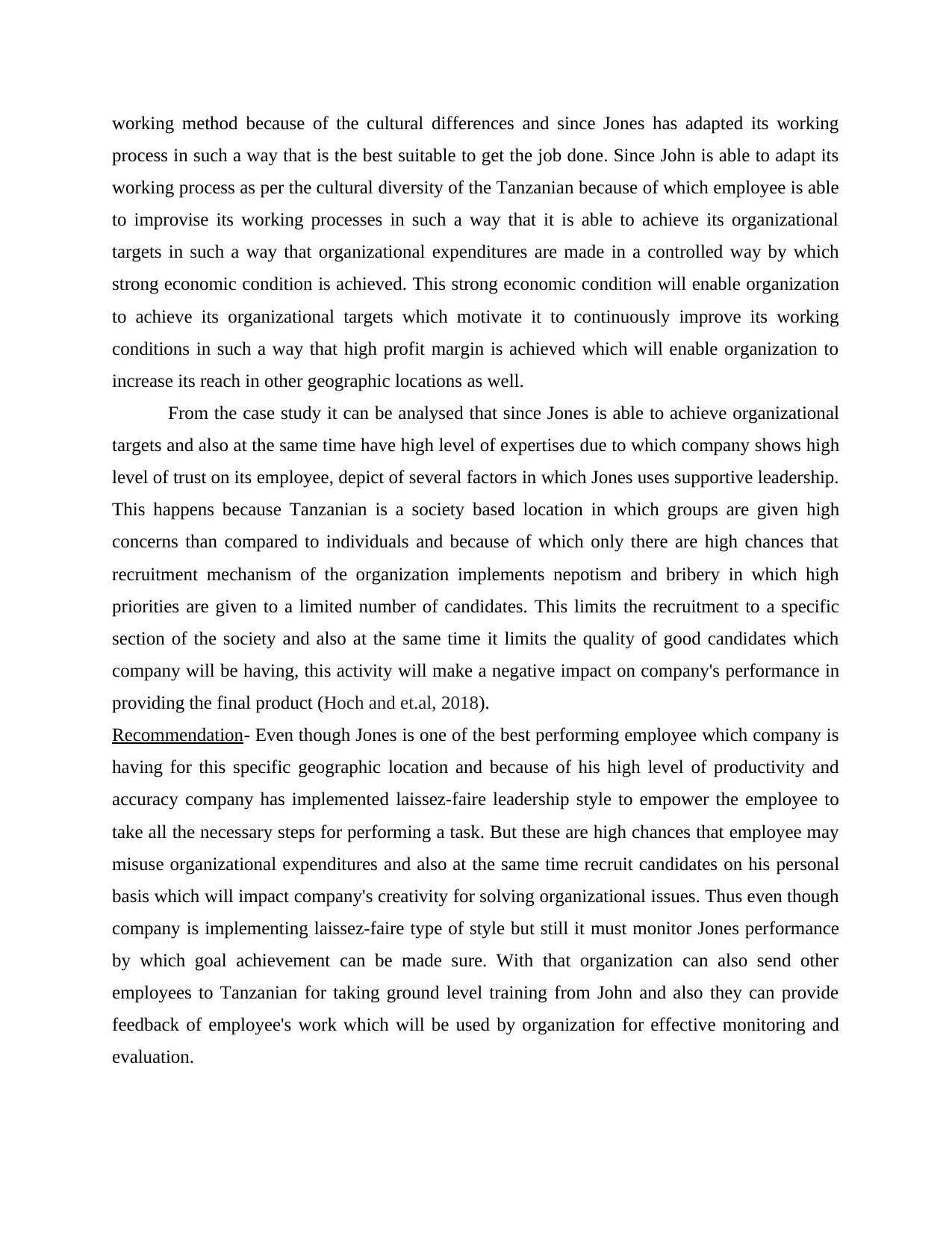
working method because of the cultural differences and since Jones has adapted its working
process in such a way that is the best suitable to get the job done. Since John is able to adapt its
working process as per the cultural diversity of the Tanzanian because of which employee is able
to improvise its working processes in such a way that it is able to achieve its organizational
targets in such a way that organizational expenditures are made in a controlled way by which
strong economic condition is achieved. This strong economic condition will enable organization
to achieve its organizational targets which motivate it to continuously improve its working
conditions in such a way that high profit margin is achieved which will enable organization to
increase its reach in other geographic locations as well.
From the case study it can be analysed that since Jones is able to achieve organizational
targets and also at the same time have high level of expertises due to which company shows high
level of trust on its employee, depict of several factors in which Jones uses supportive leadership.
This happens because Tanzanian is a society based location in which groups are given high
concerns than compared to individuals and because of which only there are high chances that
recruitment mechanism of the organization implements nepotism and bribery in which high
priorities are given to a limited number of candidates. This limits the recruitment to a specific
section of the society and also at the same time it limits the quality of good candidates which
company will be having, this activity will make a negative impact on company's performance in
providing the final product (Hoch and et.al, 2018).
Recommendation- Even though Jones is one of the best performing employee which company is
having for this specific geographic location and because of his high level of productivity and
accuracy company has implemented laissez-faire leadership style to empower the employee to
take all the necessary steps for performing a task. But these are high chances that employee may
misuse organizational expenditures and also at the same time recruit candidates on his personal
basis which will impact company's creativity for solving organizational issues. Thus even though
company is implementing laissez-faire type of style but still it must monitor Jones performance
by which goal achievement can be made sure. With that organization can also send other
employees to Tanzanian for taking ground level training from John and also they can provide
feedback of employee's work which will be used by organization for effective monitoring and
evaluation.
process in such a way that is the best suitable to get the job done. Since John is able to adapt its
working process as per the cultural diversity of the Tanzanian because of which employee is able
to improvise its working processes in such a way that it is able to achieve its organizational
targets in such a way that organizational expenditures are made in a controlled way by which
strong economic condition is achieved. This strong economic condition will enable organization
to achieve its organizational targets which motivate it to continuously improve its working
conditions in such a way that high profit margin is achieved which will enable organization to
increase its reach in other geographic locations as well.
From the case study it can be analysed that since Jones is able to achieve organizational
targets and also at the same time have high level of expertises due to which company shows high
level of trust on its employee, depict of several factors in which Jones uses supportive leadership.
This happens because Tanzanian is a society based location in which groups are given high
concerns than compared to individuals and because of which only there are high chances that
recruitment mechanism of the organization implements nepotism and bribery in which high
priorities are given to a limited number of candidates. This limits the recruitment to a specific
section of the society and also at the same time it limits the quality of good candidates which
company will be having, this activity will make a negative impact on company's performance in
providing the final product (Hoch and et.al, 2018).
Recommendation- Even though Jones is one of the best performing employee which company is
having for this specific geographic location and because of his high level of productivity and
accuracy company has implemented laissez-faire leadership style to empower the employee to
take all the necessary steps for performing a task. But these are high chances that employee may
misuse organizational expenditures and also at the same time recruit candidates on his personal
basis which will impact company's creativity for solving organizational issues. Thus even though
company is implementing laissez-faire type of style but still it must monitor Jones performance
by which goal achievement can be made sure. With that organization can also send other
employees to Tanzanian for taking ground level training from John and also they can provide
feedback of employee's work which will be used by organization for effective monitoring and
evaluation.
⊘ This is a preview!⊘
Do you want full access?
Subscribe today to unlock all pages.

Trusted by 1+ million students worldwide
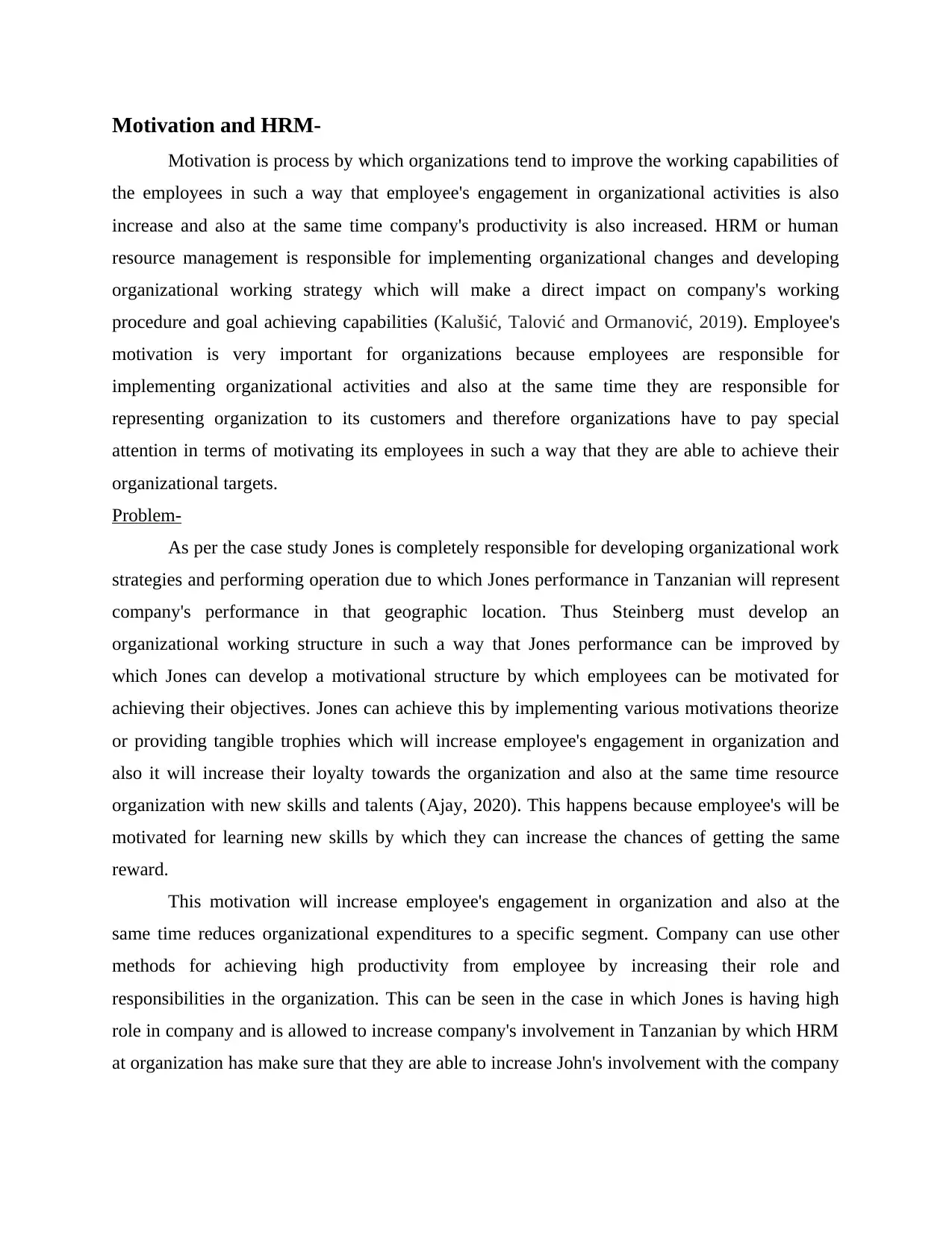
Motivation and HRM-
Motivation is process by which organizations tend to improve the working capabilities of
the employees in such a way that employee's engagement in organizational activities is also
increase and also at the same time company's productivity is also increased. HRM or human
resource management is responsible for implementing organizational changes and developing
organizational working strategy which will make a direct impact on company's working
procedure and goal achieving capabilities (Kalušić, Talović and Ormanović, 2019). Employee's
motivation is very important for organizations because employees are responsible for
implementing organizational activities and also at the same time they are responsible for
representing organization to its customers and therefore organizations have to pay special
attention in terms of motivating its employees in such a way that they are able to achieve their
organizational targets.
Problem-
As per the case study Jones is completely responsible for developing organizational work
strategies and performing operation due to which Jones performance in Tanzanian will represent
company's performance in that geographic location. Thus Steinberg must develop an
organizational working structure in such a way that Jones performance can be improved by
which Jones can develop a motivational structure by which employees can be motivated for
achieving their objectives. Jones can achieve this by implementing various motivations theorize
or providing tangible trophies which will increase employee's engagement in organization and
also it will increase their loyalty towards the organization and also at the same time resource
organization with new skills and talents (Ajay, 2020). This happens because employee's will be
motivated for learning new skills by which they can increase the chances of getting the same
reward.
This motivation will increase employee's engagement in organization and also at the
same time reduces organizational expenditures to a specific segment. Company can use other
methods for achieving high productivity from employee by increasing their role and
responsibilities in the organization. This can be seen in the case in which Jones is having high
role in company and is allowed to increase company's involvement in Tanzanian by which HRM
at organization has make sure that they are able to increase John's involvement with the company
Motivation is process by which organizations tend to improve the working capabilities of
the employees in such a way that employee's engagement in organizational activities is also
increase and also at the same time company's productivity is also increased. HRM or human
resource management is responsible for implementing organizational changes and developing
organizational working strategy which will make a direct impact on company's working
procedure and goal achieving capabilities (Kalušić, Talović and Ormanović, 2019). Employee's
motivation is very important for organizations because employees are responsible for
implementing organizational activities and also at the same time they are responsible for
representing organization to its customers and therefore organizations have to pay special
attention in terms of motivating its employees in such a way that they are able to achieve their
organizational targets.
Problem-
As per the case study Jones is completely responsible for developing organizational work
strategies and performing operation due to which Jones performance in Tanzanian will represent
company's performance in that geographic location. Thus Steinberg must develop an
organizational working structure in such a way that Jones performance can be improved by
which Jones can develop a motivational structure by which employees can be motivated for
achieving their objectives. Jones can achieve this by implementing various motivations theorize
or providing tangible trophies which will increase employee's engagement in organization and
also it will increase their loyalty towards the organization and also at the same time resource
organization with new skills and talents (Ajay, 2020). This happens because employee's will be
motivated for learning new skills by which they can increase the chances of getting the same
reward.
This motivation will increase employee's engagement in organization and also at the
same time reduces organizational expenditures to a specific segment. Company can use other
methods for achieving high productivity from employee by increasing their role and
responsibilities in the organization. This can be seen in the case in which Jones is having high
role in company and is allowed to increase company's involvement in Tanzanian by which HRM
at organization has make sure that they are able to increase John's involvement with the company
Paraphrase This Document
Need a fresh take? Get an instant paraphrase of this document with our AI Paraphraser
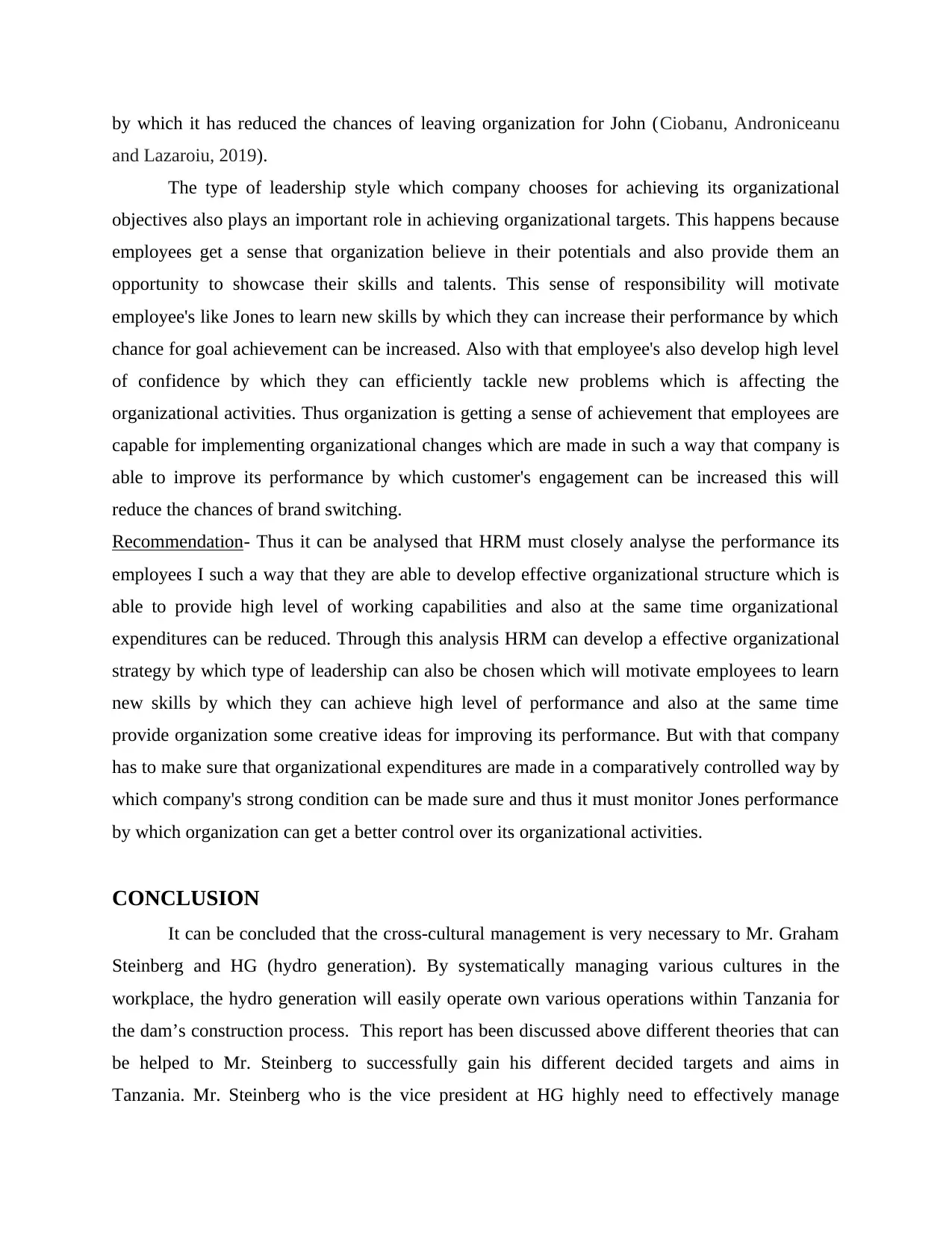
by which it has reduced the chances of leaving organization for John (Ciobanu, Androniceanu
and Lazaroiu, 2019).
The type of leadership style which company chooses for achieving its organizational
objectives also plays an important role in achieving organizational targets. This happens because
employees get a sense that organization believe in their potentials and also provide them an
opportunity to showcase their skills and talents. This sense of responsibility will motivate
employee's like Jones to learn new skills by which they can increase their performance by which
chance for goal achievement can be increased. Also with that employee's also develop high level
of confidence by which they can efficiently tackle new problems which is affecting the
organizational activities. Thus organization is getting a sense of achievement that employees are
capable for implementing organizational changes which are made in such a way that company is
able to improve its performance by which customer's engagement can be increased this will
reduce the chances of brand switching.
Recommendation- Thus it can be analysed that HRM must closely analyse the performance its
employees I such a way that they are able to develop effective organizational structure which is
able to provide high level of working capabilities and also at the same time organizational
expenditures can be reduced. Through this analysis HRM can develop a effective organizational
strategy by which type of leadership can also be chosen which will motivate employees to learn
new skills by which they can achieve high level of performance and also at the same time
provide organization some creative ideas for improving its performance. But with that company
has to make sure that organizational expenditures are made in a comparatively controlled way by
which company's strong condition can be made sure and thus it must monitor Jones performance
by which organization can get a better control over its organizational activities.
CONCLUSION
It can be concluded that the cross-cultural management is very necessary to Mr. Graham
Steinberg and HG (hydro generation). By systematically managing various cultures in the
workplace, the hydro generation will easily operate own various operations within Tanzania for
the dam’s construction process. This report has been discussed above different theories that can
be helped to Mr. Steinberg to successfully gain his different decided targets and aims in
Tanzania. Mr. Steinberg who is the vice president at HG highly need to effectively manage
and Lazaroiu, 2019).
The type of leadership style which company chooses for achieving its organizational
objectives also plays an important role in achieving organizational targets. This happens because
employees get a sense that organization believe in their potentials and also provide them an
opportunity to showcase their skills and talents. This sense of responsibility will motivate
employee's like Jones to learn new skills by which they can increase their performance by which
chance for goal achievement can be increased. Also with that employee's also develop high level
of confidence by which they can efficiently tackle new problems which is affecting the
organizational activities. Thus organization is getting a sense of achievement that employees are
capable for implementing organizational changes which are made in such a way that company is
able to improve its performance by which customer's engagement can be increased this will
reduce the chances of brand switching.
Recommendation- Thus it can be analysed that HRM must closely analyse the performance its
employees I such a way that they are able to develop effective organizational structure which is
able to provide high level of working capabilities and also at the same time organizational
expenditures can be reduced. Through this analysis HRM can develop a effective organizational
strategy by which type of leadership can also be chosen which will motivate employees to learn
new skills by which they can achieve high level of performance and also at the same time
provide organization some creative ideas for improving its performance. But with that company
has to make sure that organizational expenditures are made in a comparatively controlled way by
which company's strong condition can be made sure and thus it must monitor Jones performance
by which organization can get a better control over its organizational activities.
CONCLUSION
It can be concluded that the cross-cultural management is very necessary to Mr. Graham
Steinberg and HG (hydro generation). By systematically managing various cultures in the
workplace, the hydro generation will easily operate own various operations within Tanzania for
the dam’s construction process. This report has been discussed above different theories that can
be helped to Mr. Steinberg to successfully gain his different decided targets and aims in
Tanzania. Mr. Steinberg who is the vice president at HG highly need to effectively manage
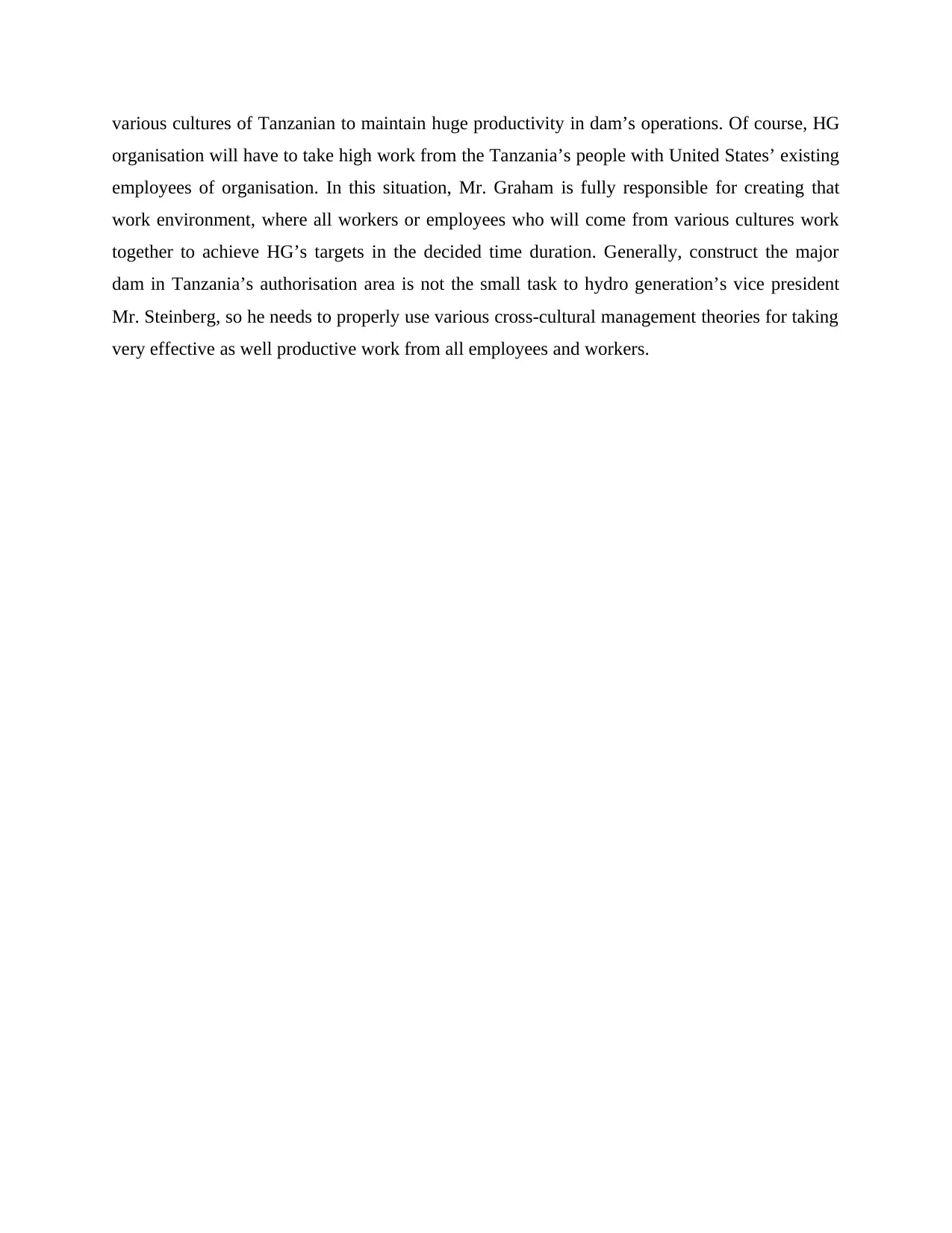
various cultures of Tanzanian to maintain huge productivity in dam’s operations. Of course, HG
organisation will have to take high work from the Tanzania’s people with United States’ existing
employees of organisation. In this situation, Mr. Graham is fully responsible for creating that
work environment, where all workers or employees who will come from various cultures work
together to achieve HG’s targets in the decided time duration. Generally, construct the major
dam in Tanzania’s authorisation area is not the small task to hydro generation’s vice president
Mr. Steinberg, so he needs to properly use various cross-cultural management theories for taking
very effective as well productive work from all employees and workers.
organisation will have to take high work from the Tanzania’s people with United States’ existing
employees of organisation. In this situation, Mr. Graham is fully responsible for creating that
work environment, where all workers or employees who will come from various cultures work
together to achieve HG’s targets in the decided time duration. Generally, construct the major
dam in Tanzania’s authorisation area is not the small task to hydro generation’s vice president
Mr. Steinberg, so he needs to properly use various cross-cultural management theories for taking
very effective as well productive work from all employees and workers.
⊘ This is a preview!⊘
Do you want full access?
Subscribe today to unlock all pages.

Trusted by 1+ million students worldwide
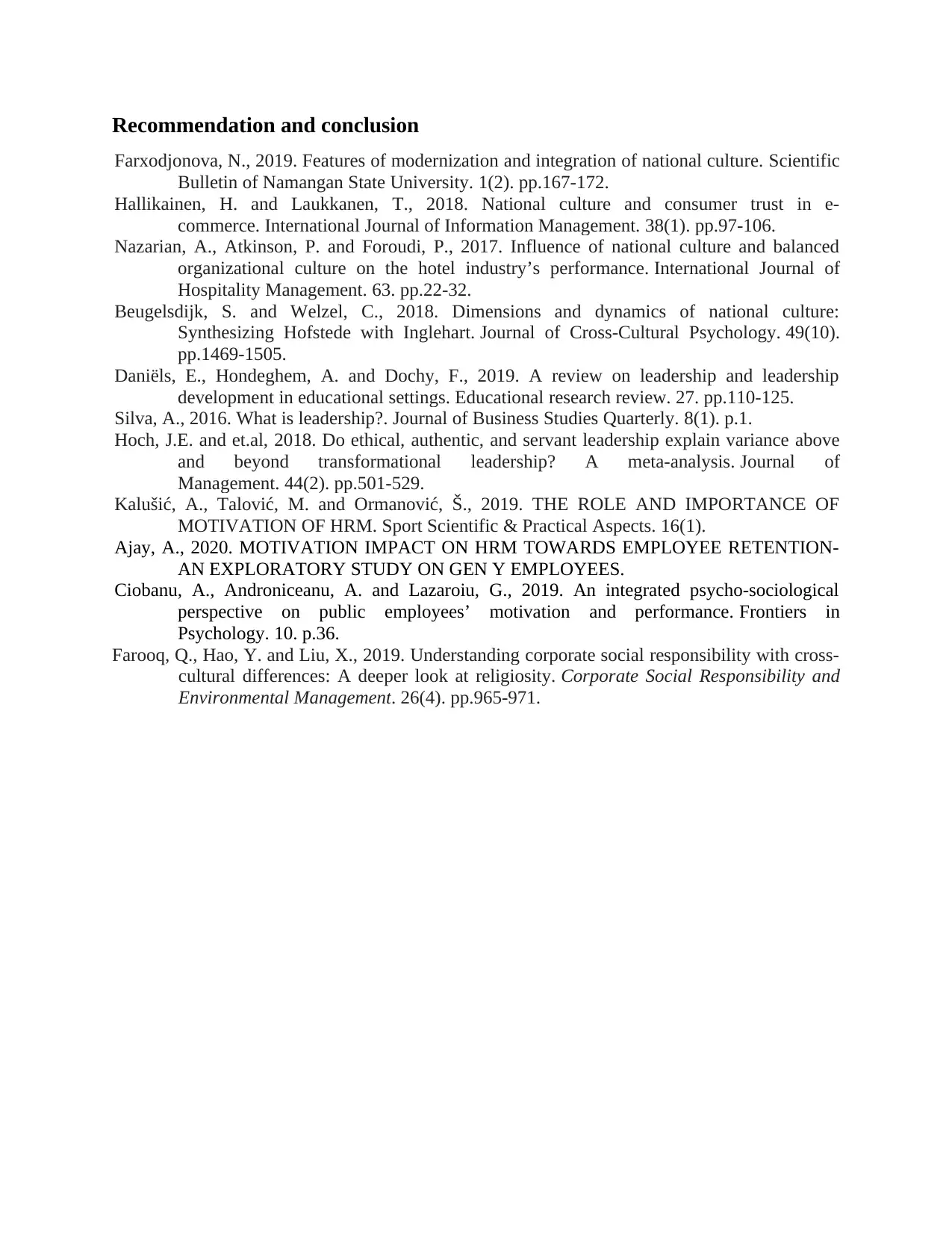
Recommendation and conclusion
Farxodjonova, N., 2019. Features of modernization and integration of national culture. Scientific
Bulletin of Namangan State University. 1(2). pp.167-172.
Hallikainen, H. and Laukkanen, T., 2018. National culture and consumer trust in e-
commerce. International Journal of Information Management. 38(1). pp.97-106.
Nazarian, A., Atkinson, P. and Foroudi, P., 2017. Influence of national culture and balanced
organizational culture on the hotel industry’s performance. International Journal of
Hospitality Management. 63. pp.22-32.
Beugelsdijk, S. and Welzel, C., 2018. Dimensions and dynamics of national culture:
Synthesizing Hofstede with Inglehart. Journal of Cross-Cultural Psychology. 49(10).
pp.1469-1505.
Daniëls, E., Hondeghem, A. and Dochy, F., 2019. A review on leadership and leadership
development in educational settings. Educational research review. 27. pp.110-125.
Silva, A., 2016. What is leadership?. Journal of Business Studies Quarterly. 8(1). p.1.
Hoch, J.E. and et.al, 2018. Do ethical, authentic, and servant leadership explain variance above
and beyond transformational leadership? A meta-analysis. Journal of
Management. 44(2). pp.501-529.
Kalušić, A., Talović, M. and Ormanović, Š., 2019. THE ROLE AND IMPORTANCE OF
MOTIVATION OF HRM. Sport Scientific & Practical Aspects. 16(1).
Ajay, A., 2020. MOTIVATION IMPACT ON HRM TOWARDS EMPLOYEE RETENTION-
AN EXPLORATORY STUDY ON GEN Y EMPLOYEES.
Ciobanu, A., Androniceanu, A. and Lazaroiu, G., 2019. An integrated psycho-sociological
perspective on public employees’ motivation and performance. Frontiers in
Psychology. 10. p.36.
Farooq, Q., Hao, Y. and Liu, X., 2019. Understanding corporate social responsibility with cross‐
cultural differences: A deeper look at religiosity. Corporate Social Responsibility and
Environmental Management. 26(4). pp.965-971.
Farxodjonova, N., 2019. Features of modernization and integration of national culture. Scientific
Bulletin of Namangan State University. 1(2). pp.167-172.
Hallikainen, H. and Laukkanen, T., 2018. National culture and consumer trust in e-
commerce. International Journal of Information Management. 38(1). pp.97-106.
Nazarian, A., Atkinson, P. and Foroudi, P., 2017. Influence of national culture and balanced
organizational culture on the hotel industry’s performance. International Journal of
Hospitality Management. 63. pp.22-32.
Beugelsdijk, S. and Welzel, C., 2018. Dimensions and dynamics of national culture:
Synthesizing Hofstede with Inglehart. Journal of Cross-Cultural Psychology. 49(10).
pp.1469-1505.
Daniëls, E., Hondeghem, A. and Dochy, F., 2019. A review on leadership and leadership
development in educational settings. Educational research review. 27. pp.110-125.
Silva, A., 2016. What is leadership?. Journal of Business Studies Quarterly. 8(1). p.1.
Hoch, J.E. and et.al, 2018. Do ethical, authentic, and servant leadership explain variance above
and beyond transformational leadership? A meta-analysis. Journal of
Management. 44(2). pp.501-529.
Kalušić, A., Talović, M. and Ormanović, Š., 2019. THE ROLE AND IMPORTANCE OF
MOTIVATION OF HRM. Sport Scientific & Practical Aspects. 16(1).
Ajay, A., 2020. MOTIVATION IMPACT ON HRM TOWARDS EMPLOYEE RETENTION-
AN EXPLORATORY STUDY ON GEN Y EMPLOYEES.
Ciobanu, A., Androniceanu, A. and Lazaroiu, G., 2019. An integrated psycho-sociological
perspective on public employees’ motivation and performance. Frontiers in
Psychology. 10. p.36.
Farooq, Q., Hao, Y. and Liu, X., 2019. Understanding corporate social responsibility with cross‐
cultural differences: A deeper look at religiosity. Corporate Social Responsibility and
Environmental Management. 26(4). pp.965-971.
Paraphrase This Document
Need a fresh take? Get an instant paraphrase of this document with our AI Paraphraser

1
1 out of 11
Related Documents
Your All-in-One AI-Powered Toolkit for Academic Success.
+13062052269
info@desklib.com
Available 24*7 on WhatsApp / Email
![[object Object]](/_next/static/media/star-bottom.7253800d.svg)
Unlock your academic potential
Copyright © 2020–2025 A2Z Services. All Rights Reserved. Developed and managed by ZUCOL.





